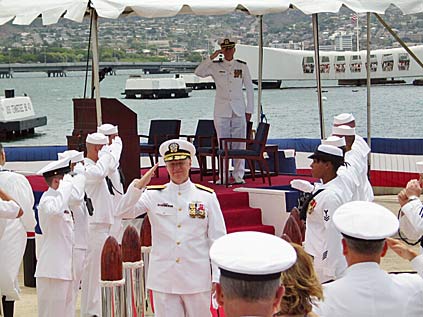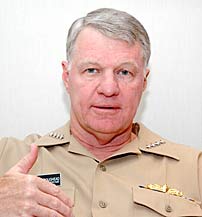
|
Admiral evaluating
ideal spot for carrier
He says it is too soon to offer
a firm stance on where a ship
would be home-ported
Five weeks into his job as commander of the Navy's largest area of responsibility, Adm. Gary Roughead says "the quality of life" for his sailors and Marines is "infinitely better" than when he first served here 12 years ago.
Adm. Gary Roughead
Age: 54
Position: Last month, Roughead became the 30th U.S. Pacific Fleet commander with responsibility over 200 vessels, 1,400 aircraft and more than 190,000 sailors, Marines and civilian workers. Experience: A 1973 graduate of the Naval Academy; Executive assistant to Pacific Forces commander Adm. Charles Larson in 1993-94; Became deputy of Pacific Command on Oct. 9 after serving as commander of the 2nd Fleet in the Atlantic, based in Norfolk, Va. Career highlights: First surface warfare officer to command both an Aegis-class destroyer, USS Barry, and the Pearl Harbor-based Aegis-class cruiser USS Port Royal in 1996-97; Served as commandant of the U.S. Naval Academy from August 1997 to April 2000; Headed the Cruiser Destroyer Group Two while serving as the USS George Washington Carrier Battle Group leader.
|
But the one thing that boggles his mind between his first tour here in 1993 and now is the traffic.
"I never saw anything like that; it's huge," Roughead said during a one-hour interview at his Makalapa Headquarters.
Roughead acknowledged that Oahu's traffic problem could influence the decision on basing a nuclear aircraft carrier with more than 6,000 sailors and another 3,000 or so family members at Pearl Harbor.
"One of the things we have to do as part of a community is to look at how the infrastructure supports what we do in the community, because it is a double-edge sword," Roughead said. "One, the inability to move around can be frustrating for our men and women, but it can also be frustrating for the community at large."
Although he is not ready to say whether a nuclear carrier should be based here or elsewhere in the Pacific, Roughead did say the aircraft carrier USS Kitty Hawk, now stationed in Japan, has to be replaced by another following the Kitty Hawk's decommissioning in three years.
Here is an edited version of Roughead's conversation last week with the Star-Bulletin.
Question: During the recent Base Realignment and Closure hearings in Washington, D.C., the Navy came out strongly on the importance of Pearl Harbor Naval Shipyard because of its overall strategic value. What is your assessment?
Answer: The fact that shipyard was not on the list and then there wasn't enough votes to add it ... reaffirms the importance of the shipyard of Pearl Harbor and the commands we have here. I think it is indicative of the value that the Navy places on the ability to operate from, to base out of and be part of the PACOM (Pacific Command) structure in Hawaii. There is tremendous value in being in the region and close to the areas of great interest to us in the Asia-Pacific area of operation. The other thing that is important, and I believe this since I have been here since 1993 in the Pacific Command, we're the only combatant command where all of the components are co-located. I think that just facilitates the way that we jointly plan and conduct operations and the ability to coordinate how we want to go forward.
Q: Since you were first stationed in the Pacific in 1993 has it gained in importance?
A: I think everyone realizes that the changes that are taking place in Asia are tied to our future prosperity and security and where the 21st century is going, and there is an awareness of that.
Q: Is it harder to convince people of the importance of the Pacific since in the past leaders like Sen. (Daniel) Inouye has noted that much of U.S. foreign police has been directed to Europe?
A: I really do believe -- and of course I may be a bit biased because of where I am, where I have been and where I have served -- but I really do believe that people do look at the Asia Pacific region. ... The fact that you have country like China that is clearly on the rise and will be important strategically and globally.
Q: What is your assessment of China?
A: As I look west I see a nation that is growing economically and is developing a military at a rate that is not insignificant. It is developing and very modern and capable military. The question I would have is what does it intend to do with it? ... There is no doubt that they are acquiring and producing this modern equipment, but to what end?
Q: What is your position on placing a nuclear carrier in Hawaii or Guam?
A: As you know we are looking at what is the right laydown. What makes the most strategic sense? There are a lot of factors that go into that. We're in the process now of trying to sort through that and determining what alignment this force structure should be. It's not just the Navy but all the services are looking at how you position forces. The fact of the matter is that the Pacific is the area and it is a maritime area. How we position ourselves is a decision that will endure for many decades. So we're making sure that we examine it, analyze it and do it right. There's great interest on how that position will be out here. We're giving it a tremendous amount of thought. How it will play out is still to be determined.
Q: Where do you want the carrier to be based?
A: I am in the process of examining it in every way I can. What I want to be able to do at the end of the day is when I make my recommendation to be able to say that this is the most sound arrangement and alignment that we need for the future. I am still in the process of doing that.
Q: What is the status of the staff study begun in October 2004 on the feasibility of home-porting a carrier at Pearl Harbor?
A: It has not been completed. Some of the information out of that is being discussed and examined. There are so many facets. There is the speed issue -- how fast can we get somewhere? There are all the support issues that go into maintaining a combat capability -- like maintenance facilities and maintenance issues. The ability for families to be supported. There is the really important piece of being able to train forces that are around you. The fact that we have a great piece of hardware, but if we don't have people on them who are trained and capable and fulfilled personally and professionally by the environment that they are in, and if they don't have ability to train and practice their skills, then it all doesn't come together. That is why the deliberations and examinations on force structure is so important, because there are so many facets that are involved.
Q: How long will your examination of these issues take?
A: I am only jumping into them during these first couple of weeks on the job. I had a perspective of the broader strategic picture when I was at PACOM for the past nine months. Now I have to get into what I call the business part of the Navy and become comfortable with it and piece it together before I can make any recommendations.
E-mail to City Desk
[News] [Business] [Features] [Sports] [Editorial] [Do It Electric!]
[Classified Ads] [Search] [Subscribe] [Info] [Letter to Editor]
[Feedback]

